Manta Ray Night Snorkel Kona | Experience the Magic Now
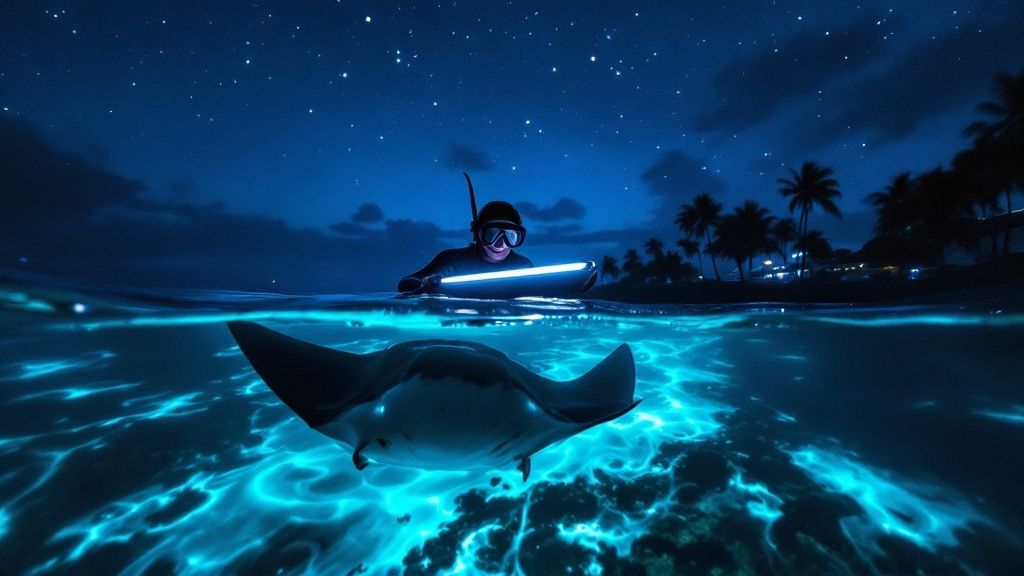
Picture this: you're floating in the warm, dark Pacific Ocean. Suddenly, a gentle giant with a wingspan of over 12 feet glides silently beneath you, close enough to see every detail. This isn't a dream—it's the manta ray night snorkel in Kona, and it's Hawaii's most talked-about wildlife adventure for a good reason.
Experience the Magic of Kona's Manta Ray Snorkel
This guide is your complete walkthrough for what is truly a once-in-a-lifetime experience. I'll break down exactly what to expect, why Kona is the best place on Earth for this, and even point you toward some of the best operators on the island, like Kona Snorkel Trips, which happens to be the top rated & most reviewed snorkel company in Hawaii.
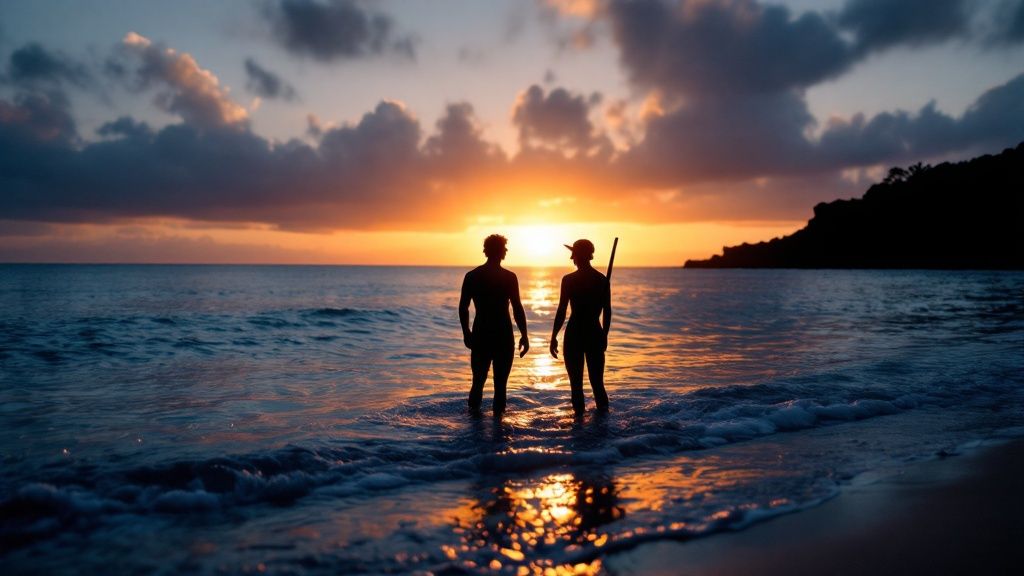
There's an undeniable pull to the manta ray night snorkel in Kona. Year after year, it’s ranked as one of the most incredible marine encounters you can have anywhere on the planet. It’s a connection with nature that’s hard to put into words.
This isn’t your typical snorkeling trip where you spend your time hunting for fish. Here, the wildlife comes directly to you. How? The tour boats set up powerful, eco-friendly lights that shine down into the water.
These lights act like a magnet for plankton, the manta rays' favorite meal. It basically creates a massive underwater buffet. All you have to do is float on the surface, holding onto a specially designed light board, and watch the show begin as these gentle giants arrive for dinner.
A Unique and Unforgettable Spectacle
What unfolds below is a mesmerizing underwater ballet. The mantas, with unbelievable grace, perform barrel rolls and somersaults as they feed, often gliding just inches from your mask. It's a deeply personal and awe-inspiring moment. For anyone looking for a top-notch alternative, I also highly recommend checking out Manta Ray Night Snorkel Hawaii for a fantastic trip.
And don't think this is just for expert swimmers or seasoned divers. Because you hold onto a flotation board the entire time, it’s an adventure that's open to almost everyone, including families with kids. The whole point is to just relax and observe, letting you soak in the absolutely breathtaking scene below.
Why Kona Is the Best Place in the World for Manta Rays
Ever wonder why Kona, Hawaii, is hands-down the best place on the entire planet to see manta rays at night? It’s not just a lucky coincidence. What we have here is a perfect storm of geography and biology that creates a truly unique natural wonder. It all starts with Kona's volcanic coastline.
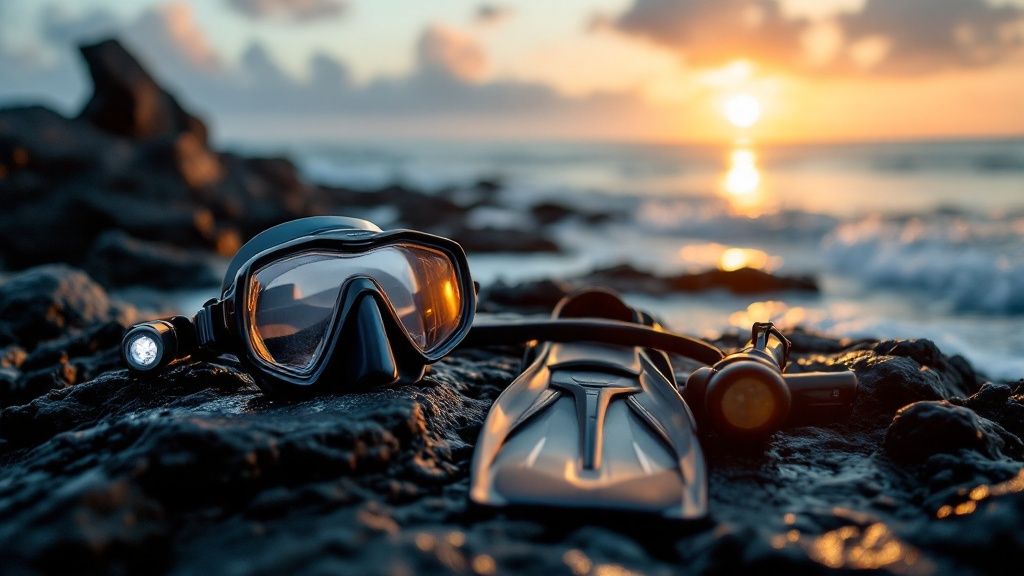
The underwater landscape here, carved out by ancient lava flows, isn't just dramatic—it's the ideal habitat. The way the ocean currents swirl around this specific topography acts like a giant funnel, concentrating massive amounts of plankton, which is the manta rays' absolute favorite meal. This dependable, all-you-can-eat buffet is exactly what keeps the mantas coming back to the same spots, night after night.
These legendary gathering places have earned their own names: "Manta Village" and "Manta Heaven." For the local manta population, they're the equivalent of a five-star restaurant that's always open, creating a predictable and jaw-dropping show for us to witness.
A Reliable Natural Spectacle
The Kona Coast has become world-famous for night snorkeling with manta rays because of this incredible setup, backed by years of dedicated conservation. The success rate for seeing these gentle giants on a tour is a staggering 80% to 90%. That makes an encounter almost a sure thing, any time of year.
This isn't your typical wildlife tour where you cross your fingers and hope for the best. Here, you're practically guaranteed an awe-inspiring experience. Knowing the science behind this nightly event just makes it that much more special. You're not just going for a swim; you're plugging into a perfectly tuned natural phenomenon.
This remarkable consistency is what really sets Kona apart from other destinations, including some of the best snorkeling spots in Kona, HI. That reliability means your adventure has an incredibly high chance of becoming a memory you'll never forget.
A Step-by-Step Look at Your Night Snorkel Adventure
So, what’s it really like to go on a manta ray night snorkel in Kona? It’s one thing to read about it, but another to picture yourself actually there. Let's walk through the whole experience, from the harbor to the moment you slip into the water. The entire trip is carefully planned to be every bit as magical as it is safe.
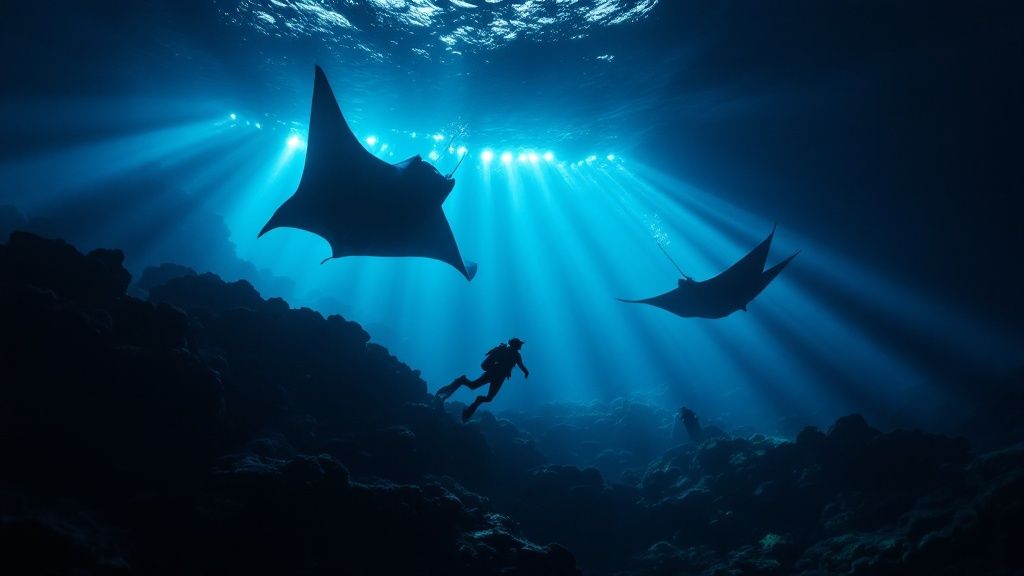
Your evening starts with a laid-back check-in at the harbor, just as the Hawaiian sun begins its slow dip toward the ocean. Once you’re on the boat, you'll be treated to a stunning ride along the Kona coast, the perfect front-row seat for a vibrant tropical sunset.
As we motor out to the snorkel spot, our guides will give you the full rundown in a safety briefing. They'll cover everything you need to know, from getting your snorkel gear just right to the golden rules of interacting respectfully with the mantas. The goal is to make sure everyone feels totally comfortable and ready for what's next.
Getting in the Water and Meeting the Light Board
Once we anchor, it’s time for the main event. You’ll slide into the surprisingly warm, dark ocean—and this is where the real magic begins. You won’t be swimming around on your own. Instead, you'll grab onto a custom-built, floating light board, which is the secret sauce to the whole experience.
This board has powerful lights pointing straight down into the water. Why? To attract a massive cloud of microscopic plankton, creating an irresistible, all-you-can-eat buffet that draws the manta rays in for their nightly ballet.
Think of the light board as a dinner bell for the mantas. It creates a brightly lit "stage" full of plankton, giving you a front-row seat to one of nature's greatest shows without you having to swim a stroke.
You’ll just float comfortably at the surface, holding on as these gentle giants perform incredible barrel rolls and graceful glides, sometimes just inches below you. This up-close-and-personal encounter is what makes the manta ray night snorkel Kona experience so unforgettable.
If you’re hoping to capture these amazing moments, knowing how to take underwater pictures can make all the difference in bringing those memories home. From start to finish, it’s an immersive, peaceful, and absolutely awe-inspiring adventure.
How to Prepare for Your Manta Ray Encounter
Getting ready for your manta ray snorkel is about more than just showing up. A little bit of prep work can be the difference between a good night and an absolutely unforgettable one. Knowing what to bring and what your tour company has covered means you can just relax and soak in the magic unfolding below.
First off, let’s talk comfort. Even though Hawaii’s waters are warm, the boat ride back to the harbor under the stars can get surprisingly chilly once you’re out of the water. Tossing a warm towel and a windbreaker or sweater in your bag is a pro move—you'll be glad you have it. And while it's a night tour, it's still smart to apply reef-safe sunscreen beforehand to protect the delicate corals from any chemicals that might wash off.
Your Manta Ray Snorkel Checklist
Your tour operator will have all the essential snorkel gear waiting for you, but bringing a few personal items will make your experience that much better. Here’s a quick breakdown of what you should pack versus what’s typically provided.
| Item | What to Bring | Usually Provided by Tour |
|---|---|---|
| Snorkel Gear | High-quality snorkel, mask, and fins | |
| Wetsuit | For warmth and buoyancy | |
| Flotation | A large, stable light board to hold | |
| Swimsuit | Arrive wearing it under your clothes | |
| Warm Layers | A warm towel, a change of clothes, or a cover-up | |
| Sunscreen | Reef-safe sunscreen (apply before the trip) | |
| Camera | An underwater camera like a GoPro | |
| Medication | Any needed motion sickness medicine (take before boarding) | |
| Expertise | In-water guides and a thorough safety briefing |
Packing just a few of these items yourself ensures you're totally comfortable from the moment you step on the boat to the moment you get back to shore.
Feeling a little nervous or maybe you're not the strongest swimmer? Don't sweat it. This tour is designed for everyone, regardless of their experience level. You'll be snug in a buoyant wetsuit and holding onto a large, stable float the whole time. There’s really no swimming required at all—you just float and watch the show.
For a deeper dive into ocean readiness, you can brush up on these essential snorkeling safety tips. And remember, you'll have expert guides right there with you, making sure you feel safe and secure so you can focus on the incredible manta ballet happening right below you.
Snorkeling Responsibly with Marine Wildlife
Being in the water with Kona's manta rays is an incredible privilege, and with that comes the responsibility to protect these gentle giants. The entire experience is built on a foundation of deep respect for the marine environment, making sure the mantas stay safe and completely undisturbed in their natural habitat.
When you understand these simple but vital guidelines, your tour transforms from just a fun activity into a meaningful act of eco-tourism.
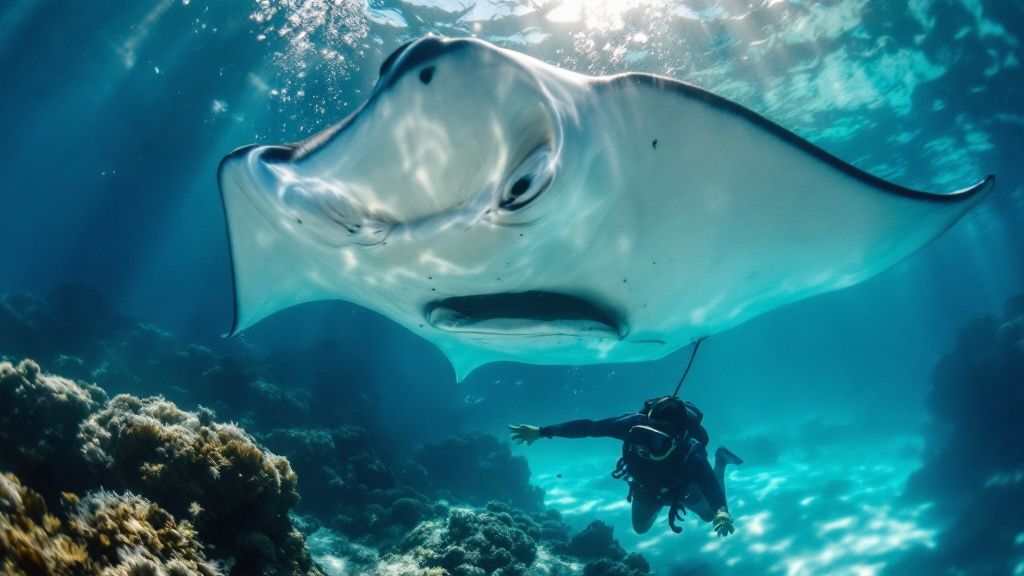
The core principle here is passive interaction. Think of it less like an active swimming tour and more like being a respectful audience member at a spectacular underwater ballet. You'll be floating on the surface, holding onto a light board, and simply observing the breathtaking show below.
The Golden Rules of Manta Interaction
To ensure the health and safety of Kona's beloved manta ray population, every reputable tour operator enforces a strict set of rules. These aren't just suggestions—they are absolutely essential for the long-term sustainability of this amazing encounter.
- Look, Don't Touch: This is the #1 rule, and it's non-negotiable. Manta rays have a special mucous coating on their skin that acts like a shield against infection. Touching them, even accidentally, can strip away this protective layer and leave them vulnerable to disease.
- Stay on the Surface: Snorkelers must remain at the surface, holding onto their flotation device. Don't be tempted to dive down toward the mantas. Doing so can startle them and disrupt their natural feeding patterns.
- Let Them Approach You: It's tough, but you have to resist the urge to chase or swim after the mantas. By staying still and calm, you create a safe space for them. Ironically, this often results in much closer and more magical encounters as they feel comfortable enough to come right up to you.
Following these simple rules is our collective promise to the mantas. It's how we ensure this incredible Kona adventure remains a safe and sustainable experience for generations of people—and rays—to come.
Getting to Know Kona's Famous Manta Rays
When you go on a manta ray night snorkel in Kona, you’re not just looking at a group of random sea animals. You're actually meeting the local celebrities, and many of them have names that the guides and researchers have been using for years.
So, how is this possible? It all comes down to the fascinating science of telling one manta from another. Each ray has a totally unique pattern of black spots on its white belly, which works just like a human fingerprint. These distinct markings are how we can identify and track individual mantas over their incredibly long lives—some live for up to 50 years!
Meeting Kona's Resident Rays
By snapping photos of their bellies, researchers have put together a huge catalog of Kona's resident manta population. This is what lets your guide tell you the story of a famous ray like "Big Bertha" or "Lefty," turning your snorkel trip from just wildlife watching into a real introduction to some well-known personalities.
This tracking has also shown us something incredible called site fidelity. It means these mantas tend to come back to the exact same feeding spots, night after night. Their loyalty to these sites is precisely why the success rate for seeing them is so ridiculously high. In fact, some individual mantas show up almost every single night, and the ratio of trips that go out to successful sightings is nearly 1:1. It’s a powerful testament to how established and reliable this natural wonder really is. If you're curious, you can check out a detailed statistical report on Kona's manta sightings from 2013.
Your Questions Answered About the Manta Ray Night Snorkel
Even after getting pumped up about this adventure, it's totally normal to have a few questions floating around before you commit. We get it. You want to be sure it's the right fit. Here are the answers to the questions we hear the most from people just like you.
Is This Snorkel Tour Safe for Kids?
Absolutely! This is a fantastic and unforgettable experience for the whole family. Most tour operators are happy to have kids on board, usually starting around five to seven years old, and they’ll have all the right-sized gear ready to go.
The whole setup is incredibly safe. Everyone floats at the surface, holding onto a big, stable light board. The guides are always right there in the water with you, keeping an extra-close eye on the younger snorkelers to make sure they're having a blast safely. Just be sure to double-check the minimum age with your specific tour company when you book.
When Is the Best Time of Year to See Manta Rays?
This is the best part—there isn't one! You can't go wrong. The manta rays here in Kona are a resident population, which means they live here year-round and don’t migrate off to somewhere else.
Because of this, sightings are remarkably consistent no matter when you visit. Summer, winter, spring, or fall, your chances of a mind-blowing encounter are excellent any month you come to the Big Island.
Do I Need to Be a Strong Swimmer?
Not at all. This is probably the biggest myth we hear, and it sadly keeps some people from what could be the highlight of their trip. You really don't need to be a great swimmer to do this.
Everyone wears a wetsuit, which makes you incredibly buoyant, and you'll be holding onto a large floatation board the entire time. There's no actual swimming involved—you just get to float comfortably and watch the show unfold beneath you. It makes the tour super accessible and fun for almost everyone, no matter how confident you are in the water.
